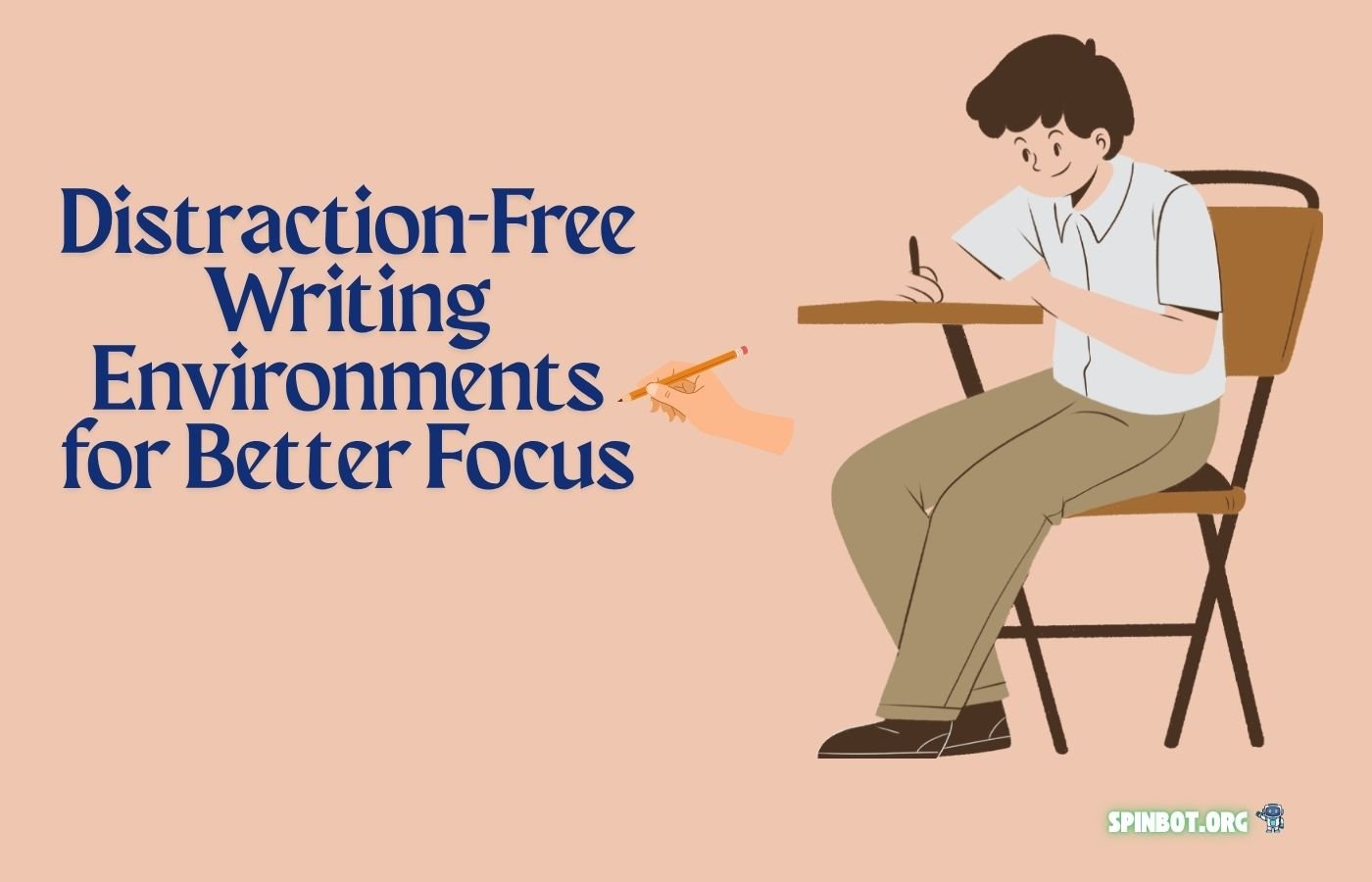In this article, we’ll explore how to build your ideal writing zone, share practical tips, and review tools that help eliminate interruptions and sharpen focus.
The Science of Focus: Why Distraction Hurts Your Writing
Distractions interrupt the brain’s flow state—the mental zone where productivity and creativity peak. Every time you switch from writing to check a notification or think about something else, your brain loses momentum. According to a University of California Irvine study, it takes over 23 minutes to fully regain focus after an interruption.
Consequences of constant distractions:
- Lower word count and poor writing quality
- Mental fatigue and burnout
- Difficulty reaching deep concentration
To write at your best, you must protect your attention like a precious resource.
Common Distractions That Derail Writing
Recognizing what breaks your focus is the first step to eliminating it. Distractions come in many forms:
Digital distractions
- Social media notifications
- Constant emails or messages
- Web browsing or streaming
Physical distractions
- Cluttered desk or uncomfortable chair
- Background noise (TV, conversations, traffic)
- Poor lighting or room temperature
Mental distractions
- Overthinking
- Multitasking
- Stress or anxiety
Knowing your triggers helps you build a writing environment that works with your brain, not against it.
Elements of a Distraction-Free Writing Environment
So what is the best environment for writing? It’s not just about being alone in a quiet room. A truly distraction-free space combines physical setup, digital tools, and mental habits.
Key elements of productive writing environments:
- Quiet and solitude: Choose a spot with minimal noise or use noise-canceling headphones.
- Clutter-free space: Keep only essential tools on your desk.
- Comfortable seating and lighting: Ergonomic chairs and natural lighting help reduce fatigue.
- Intentional time blocks: Schedule focused writing sessions without interruptions.
- Digital minimalism: Use clean writing apps and disable notifications.
How to Create a Distraction-Free Environment
If you’re wondering how to create a distraction-free environment, it starts with conscious design choices.
Step-by-step guide:
- Pick a dedicated writing zone. Choose a room or corner free from noise and foot traffic.
- Declutter your workspace. Remove everything not related to your writing task.
- Set the atmosphere. Adjust lighting, temperature, and use calming sounds if needed.
- Control tech interruptions. Turn off phone notifications or use Airplane Mode.
- Use distraction-free writing tools. More on that below.
Your environment should signal to your brain: “This is where writing happens.”
Best Distraction-Free Writing Apps and Tools
Many writers use digital tools to keep their focus razor-sharp. A distraction-free writing app eliminates formatting clutter and other features that pull you away from the words.
Popular apps to try:
| App Name | Platform | Key Feature |
|---|---|---|
| iA Writer | Mac, iOS, Android | Minimalist design with syntax highlighting |
| FocusWriter | Windows, Linux, Mac | Full-screen mode to block all distractions |
| Ulysses | Mac, iOS | Seamless focus and organization |
| Scrivener | Windows, Mac | Ideal for long-form and structured writing |
| ZenWriter | Windows | Ambient music and clean interface |
You can find distraction free writing environments download options or PDFs of setups and checklists to maintain your space.
Designing the Perfect Physical Writing Space
Your physical surroundings have a strong effect on mental clarity. Here’s how to set up your space:
Choose a good location:
- Home office or quiet room
- Libraries or coworking spaces
- Nature-inspired settings
Tips for physical setup:
- Use a comfortable chair to avoid back strain
- Natural light boosts mood and alertness
- Keep water or tea nearby to stay hydrated
- Hang inspiring quotes or visuals to stay motivated
Even small changes—like moving your desk away from the TV—can improve focus.
Daily Habits to Support Distraction-Free Writing
A clean space is just one part of the puzzle. Writing without being distracted also requires discipline.
Adopt these habits:
- Write during peak energy hours (early morning or late night)
- Use time blocks (e.g., Pomodoro Technique)
- Start with a 2-minute mental reset (deep breathing or affirmations)
- Set clear word count goals for each session
- Track your progress daily
These habits help students, bloggers, and professionals stay on track.
Distraction-Free Writing Environments for Students
Students often face unique challenges: roommates, noise, and study burnout. Creating a personal writing zone can make a huge difference in school performance.
Tips for students:
- Use campus libraries or quiet corners
- Avoid multitasking—focus only on one assignment
- Use ambient music (like Brain.fm) to block background noise
- Try distraction-free writing app extensions for Chrome or Firefox
- Print a distraction free writing environments PDF as a checklist to review before writing
Small improvements can lead to better essays, faster thesis writing, and improved academic results.
Mobile and On-the-Go Writing Strategies
Writers often need flexibility. Here’s how to write without being distracted when you’re not at your desk:
Try these mobile habits:
- Use mobile-friendly writing apps like Bear or JotterPad
- Dictate ideas using voice-to-text tools
- Block notifications or use Do Not Disturb mode
- Carry a physical notebook for offline writing
Consistency matters more than location. Stay focused wherever you write.
Real-Life Examples: How Writers Eliminate Distractions
Many professional writers create routines that help them get into the zone. Ernest Hemingway wrote standing up, early in the morning, with no one around. JK Rowling wrote Harry Potter in cafés because they offered a change of pace.
Common practices:
- Morning routines that include exercise and quiet time
- Using the same playlist to signal “writing time”
- Rewarding themselves after reaching writing goals
These systems help train the brain to focus on command.
Benefits of Distraction-Free Writing
The results of building the right environment and habits are powerful.
What you gain:
- Higher word counts and faster draft completion
- Improved quality and fewer editing sessions
- Better mental well-being from reduced stress
- Stronger creative ideas through deep thinking
You don’t need more time—you need more focused time.
Final Action Plan: Start Building Your Ideal Writing Space
Let’s wrap up with an action plan. Here’s how to start building distraction-free writing environments today:
Your 7-step checklist:
- Choose and clear your writing space
- Remove all non-writing clutter
- Block all notifications and interruptions
- Use a focused writing app or tool
- Set a timer for 25-50 minutes
- Write without editing or checking anything else
- Repeat daily and improve your setup weekly
Every writer is different, so test what works best for you.
Conclusion
Distraction-free writing environments aren’t about perfection—they’re about intention. By creating a space that protects your focus and supports your flow, you can unlock your true writing potential. Whether you’re working on a novel, blog post, research paper, or essay, your words deserve your full attention.
Try implementing just one tip today. You’ll be amazed how much smoother and faster your writing becomes.

Academic editor turned AI copy pro, Sarah-Jane fuses research precision with smart storytelling. Her insights build trust, spark ideas, and elevate every word with real-world writing experience.

